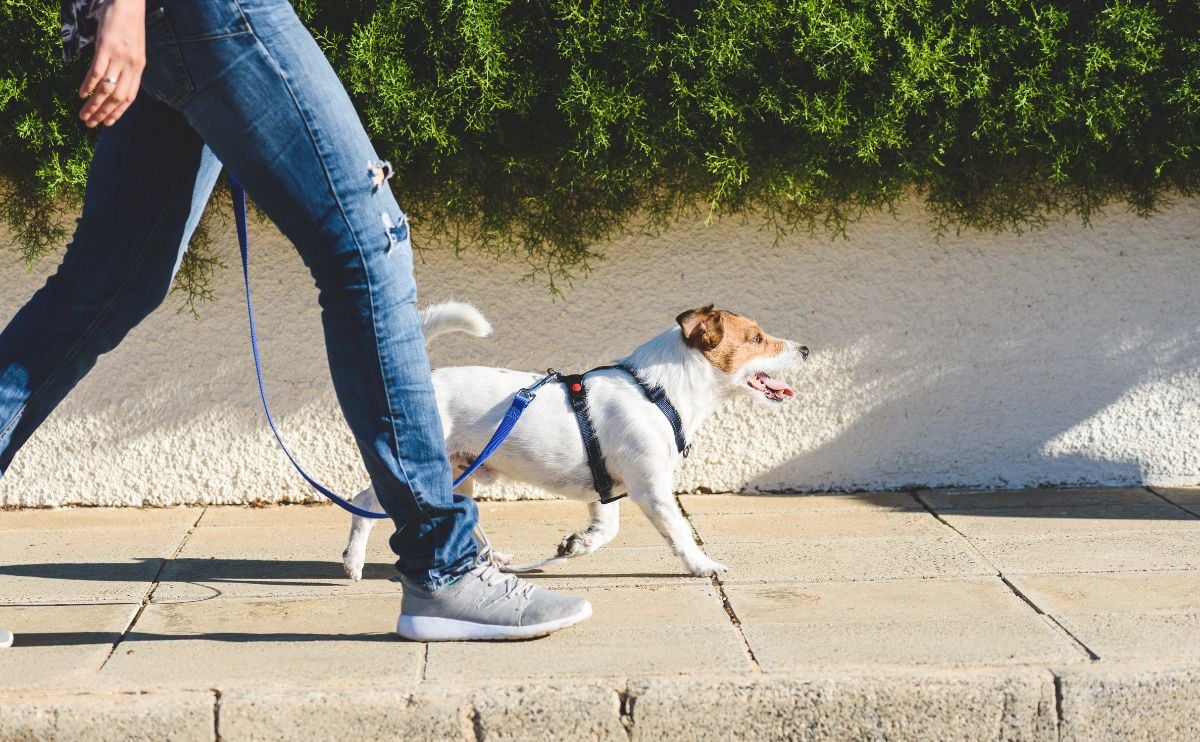When you purchase through links on our site, we may earn a commission. Here’s how it works.

We all know that dogs require regular potty breaks and exercise. And unless you’re lucky enough to have a fenced-in yard, walking your dog is the best way to meet your pup’s basic needs — and have an enjoyable bonding experience. But is there a standard guideline on how often and how long you should walk your dog? As with most things canine-related, the answer is that it depends on your individual dog.
We share all the factors you need to consider about how much to walk your four-legged friend, as well as some general recommendations for your pup’s age, breed, and more. Regardless of your dog’s limitations or specific needs, veterinarians agree that regular walks are among the best things you can do for your canine companion.
Why Is Walking Your Dog So Important?
Walking your dog and other forms of exercise are crucial for their physical and mental health. Just like humans, dogs need regular exercise to stay healthy and fit. Some of the multiple benefits of walking for both you and your best buddy include:
- Supports muscle, bone, and joint health.
- Important for weight control. Even a few extra pounds on a dog can result in long-term health issues, such as heart disease, diabetes, arthritis, and more.
- Good for digestive health not only for regular pee and poop breaks but to keep the digestive system working properly.
- Provides your pup much-needed mental stimulation and social interaction.
- Helps curb behavioral problems that can stem from boredom and anxiety.
- Special bonding time for you and your pup.
How Often Do You Walk A Dog?
How many walks does a dog need each day? There’s no one-size-fits-all guide on dog walking, but experts agree that dogs should have at least one walk every day. Although many need two or more.
The main factors that affect how often (and how long) to walk a dog include your pup’s age, breed, body condition, any health problems she may have, and how well your furry friend tolerates exercise.
5 Main Factors That Affect How Much To Walk A Dog
So, how do you determine how much exercise your dog needs? We’ve compiled this guide on all the factors you’ll need to consider to figure out how often you should walk your dog.
1. Age
Your pup’s age can make a big difference in how often you walk him.
Puppies
How much to walk a puppy depends on his age. A common guideline to follow is that puppies should have no more than five minutes of exercise per month of age each day. For example, if your puppy is five months old, you can walk him for up to 25 minutes per day.
However, you should break this total exercise time down into multiple sessions during the day. Because puppies’ bones and joints are still forming, they’re more prone to injuries. So, it’s important to keep the time and distance of each walk fairly short.
Adult Dogs
Adult dogs (especially younger adults) have more stamina and need more exercise than they do when they’re puppies or seniors. But how often and how long to walk your individual adult dog depends on his energy level, size, breed, and temperament. In general, small dogs do well with shorter walks (in terms of distance and time) because their little legs work much harder to cover the same ground as larger dogs.
Senior Dogs
Although energy levels and endurance are lower in middle-aged and senior dogs, they still require some exercise to stay as healthy as possible. Again, it comes down to your individual dog’s needs and limitations. Older dogs with arthritis, heart issues, diabetes, or other health problems, may only be able to handle very short walks once or twice each day.
2. Breed
While a dog’s size can make a difference in how much exercise they need, your dog’s breed can be a huge factor. Highly-active breeds, particularly working breeds, need longer walks more often than low-energy breeds. Here are a few examples of breed energy levels.
| High-Energy Breeds | Low-Energy Breeds |
|---|---|
| Australian Shepherds | Basset Hounds |
| Border Collies | Bulldogs |
| German Shepherds | Great Danes |
| Golden Retrievers | Greyhounds |
| Jack Russell Terriers | Mastiffs |
| Labrador Retrievers | Newfoundlands |
| Siberian Huskies | Pugs |
| Shih Tzus |
3. Exercise Intolerance
Flat-faced (brachycephalic) breeds, such as French Bulldogs, Pugs, and Shih Tzus, have varying degrees of airway obstructions due to the shape of their snouts and heads. Many require very limited exercise and exposure to heat and humidity because they can overheat easily.
Some dogs also suffer from a hereditary condition called Exercise Induced Collapse (EIC), which can cause an otherwise healthy dog to suddenly become weak, and his hindquarters will collapse after 5 to 15 minutes of strenuous exercise, such as chasing a ball. Dogs with EIC are typically fine with a slow to moderate-paced walk, but vigorous walks or jogging can be risky. Labrador Retrievers are particularly prone to EIC.
4. Health Issues
Many different health problems can make frequent, long, or strenuous walks too challenging for dogs. Some examples include arthritis, hip dysplasia, a luxating patella, heart disease, diabetes, and hypothyroidism. Also, obese or overweight dogs often have trouble with long walks. Despite these health limitations, it’s still extremely important to walk or exercise your dog. Your vet is your best resource to determine a safe exercise plan for your pup’s specific condition.
5. Indoor Space
Another factor to consider is the space in your home for your dog to run around and explore. For example, if you live in a very small apartment with no yard, your pup may need to go on more frequent walks each day for his physical and mental health.
How Long Should You Walk A Dog?
The generally recommended minimum length for a dog walk is 15 to 30 minutes when taking several walks per day. If you’re only able to walk your pup once a day, vets typically advise at least a 45- to-60 minute walk.
However, very elderly pups or those with serious health conditions simply can’t make it that long. Alternatively, high-energy dogs and those in excellent health may enjoy walks for one to two hours long. By taking into account all the factors we outlined above, you can determine what’s appropriate for your pup’s specific needs or limitations. Or your veterinarian can advise you on the best walking routine for your four-legged friend.
Frequently Asked Questions
Here’s some additional information in case you have other questions we haven’t already covered in our article.
When Is It Too Hot To Walk A Dog?
Our pups are more prone to heat stroke than us, so paying attention to the outdoor temperature and other conditions (like the humidity level and whether there’s a breeze) is extremely important before taking your furball on a walk. In general, it’s safe to take all dogs for a walk at temperatures up to about 70 degrees F.
In temps over 70F and even more so over 80F, you’ll need to keep an eye on large, very young, overweight, or flat-faced dogs (in addition to those with health problems) as they’re more susceptible to heat stroke. At temperatures over 90 degrees F, all dogs are at a high risk of developing heat stroke.
Should You Walk A Dog With Luxating Patella Or Other Joint Problems?
Yes, it’s still important to walk dogs suffering from joint issues, although walks should be kept fairly short in most cases. Walking a dog with hip dysplasia or a luxating patella can help prevent arthritis and keep your dog in shape. And regular walks for pups already exhibiting signs of arthritis can help lessen the severity and delay the progression of this chronic disease. Hydrotherapy is also a beneficial exercise for dogs with joint problems.
What If I Can’t Walk My Dog Every Day Or As Much As He Needs?
Missing a daily walk once in a while doesn’t mean you’re a neglectful pup parent as long as he’s getting some type of exercise. However, if you work long hours or have ongoing physical constraints that limit your ability to walk your pup, the ideal solution is to hire a dog walker. You may be able to find a middle school or high school student that lives in your neighborhood that does dog walking on the side.
Or many people have success using a dog walking app, like Wag! or Rover, that connects you with walkers in your area. Through these services, you can find professional walkers that have insurance and bonding to protect you from potential accidents and injuries.
Training Your Dog To Walk With Good Manners (Video)
Many owners don’t walk their dogs as much as they should (or at all) because of problems with leash-pulling, reactive behavior toward other dogs or people, and other issues that make walks a nightmare. If this sounds all too familiar, check out the brief video below by Doggy Dan, a popular online dog trainer, for some tips on how to put an end to leash-pulling.
If you need expert help to get your dog to behave on walks, you may want to consider taking a virtual course led by a professional dog trainer like Doggy Dan or SpiritDog Training. Our reviews of the best online dog training services may help you find an affordable and effective training aide.
Keeping Tabs On Your Dog’s Fitness
If you’re concerned your pup isn’t meeting his daily exercise needs, you may want to consider getting a dog activity tracker. These wearable smart devices allow you to monitor how much time your dog is active versus sedentary (and calories burned) during the day, set ideal fitness goals based on your dog’s breed, age, and weight, and even track your pup using GPS technology if he gets lost. It’s like having a super-charged Fitbit for your furry friend.
Tagged With: Exercise

